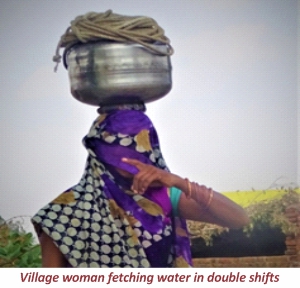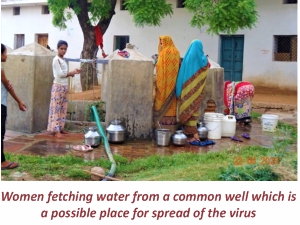|
COVID and Water Crisis in Rural Bundelkhand
Lockdown due to the Corona pandemic has hit every section of the society. Village communities got disconnected from the external world. Panchayat authorities were given the responsibility to monitor implementation of government orders to prevent the spread of virus.
During the pandemic, rural household needs
of water have increased as
Focussed group discussions and personal interviews by the Development Alternatives Team conducted in a few villages revealed inadequate or no measures taken for ensuring cleanliness around the hand pumps/ bore wells/ water scheme intake points resulting in source contamination. Other factors affecting the communities pertain to inequitable distribution and access to drinking water sources, improper and inadequate chlorination, no periodic testing of water samples and ineffective or non-functioning Gram Panchayat Water and Sanitation Committees. Lack of regular checking of pipelines and inadequate maintenance causes breakdown in water supply and contamination of water sources. Lack of certain essential spare parts for hand pumps etc. aggravates the water woes of the villages. One of the women said, “Half of my day is spent in bringing water. Water is the main concern about which we think all day and night. Corona is not our concern.” The collection of water by women in groups from the common water sources can be the possible place for spread of the virus. One can see people sitting in groups at common places in the day time and visiting each other’s houses without any precautions such as wearing a mask.
Possible Solutions
The Gram Panchayat of every village will have to consider the relative water yield from different sources and plan to meet its drinking water requirements accordingly. This includes assessing the financial suitability of the measures depending upon various factors. The most common drinking water supply systems in rural areas of Bundelkhand are: dug wells, hand pumps, tube wells, bore wells, ponds, tanks, surface water harvesting structures and large surface water based piped systems. Out of the above, hand pump is the most widely used water source for meeting the drinking water needs of the rural communities. The main feature of the hand pump is that the bore hole is fitted with a pump. In all types of hand pumps, the bore hole should be sealed to prevent the entry of surface water. It is also important that a platform should be constructed around the hand pump, so that the waste water can be led away to a soak pit or leach pit around 3 metres from the hand pump. If operated and maintained well, it can last longer than other systems and yield ground water that is free from anthropogenic chemical contamination. This basic understanding about the sources and systems would help the Gram Panchayats in planning for their water safety and security. ■
Diksha Singh
|
 frequency
of hand wash has increased in every household and also the practice of
cleaning their houses and surrounding areas. Women folk and girls are
forced to walk long distances to fetch drinking water, causing hardship
and adversely affecting their health, education and engagement in
productive activities. The paucity of time due to the water crisis has
aggravated domestic problems as the rural women have gotten over loaded
with more household work as their husbands have been unemployed and
staying at home and children not going to school.
frequency
of hand wash has increased in every household and also the practice of
cleaning their houses and surrounding areas. Women folk and girls are
forced to walk long distances to fetch drinking water, causing hardship
and adversely affecting their health, education and engagement in
productive activities. The paucity of time due to the water crisis has
aggravated domestic problems as the rural women have gotten over loaded
with more household work as their husbands have been unemployed and
staying at home and children not going to school. 